Effects of Silicone Oil Viscosity and Carbonyl Iron Particle Weight Fraction and Size on Yield Stress for Magnetorheological Grease Based on a New Preparation Technique
Abstract
1. Introduction
2. Materials and Methods
2.1. Materials
2.2. Input Parameters and Response Parameters
2.3. Experiment Design
2.4. Material Preparation
2.5. Rheological Characterization
3. Results and Discussions
3.1. Qualitative Significance Evaluation of SOV, CIPs Fraction, and CIP Size towards Yield Stress
3.2. Quantitative Evaluation for Strength Effects of SOV, CIPs Fraction and Size on Yield Stress
3.3. Direction of The Discrepancy and Constitutive Relation Characterization between SOV, CIPs Fraction, and Yield Stress Based on the Regression Equations
4. Conclusions
Author Contributions
Funding
Acknowledgments
Conflicts of Interest
References
- Park, B.J.; Fang, F.F.; Choi, H.J. Magnetorheology: Materials and application. Soft Matter 2010, 6, 5246–5253. [Google Scholar] [CrossRef]
- Ahamed, R.; CHOI, S.B.; Ferdaus, M.M. A state of art on magneto-rheological materials and their potential applications. J. Intell. Mater. Syst. Struct. 2018, 29, 2051–2095. [Google Scholar] [CrossRef]
- Utami, D.; Ubaidillah; Mazlan, S.A.; Imaduddin, F.; Nordin, N.A.; Bahiuddin, I.; Aziz, S.A.A.; Mohamad, N.; Choi, S.B. Material Characterization of a Magnetorheological Fluid Subjected to Long-Term Operation in Damper. Materials 2018, 11, 2195. [Google Scholar] [CrossRef] [PubMed]
- De Vicente, J.; Klingenberg, D.J.; Hidalgo-Alvarez, R. Magnetorheological fluids: A review. Soft Matter 2011, 7, 3701–3710. [Google Scholar] [CrossRef]
- Rankin, P.J.; Horvath, A.T.; Kligenberg, D.J. Magnetorheology in viscoplastic media. Rheol. Acta 1999, 38, 471–477. [Google Scholar] [CrossRef]
- López-López, M.T.; Zugaldía, A.; González-Caballero, F.; Durán, J.D.G. Sedimentation and redispersion phenomena in iron-based magnetorheological fluids. J. Rheol. 2006, 50, 543. [Google Scholar] [CrossRef]
- López-López, M.T.; de Vicente, J.; González-Caballero, F.; Durán, J.D.G. Stability of magnetizable colloidal suspensions by addition of oleic acid and silica nanoparticles. Colloids Surf. A 2005, 264, 75–81. [Google Scholar] [CrossRef]
- Dang, A.; Ooi, L.; Fales, J.; Stroeve, P. Yield Stress Measurements of Magnetorheological Fluids in Tubes. Ind. Eng. Chem. Res. 2000, 39, 2269–2274. [Google Scholar] [CrossRef]
- Son, K.J. A discrete element model for the influence of surfactants on sedimentation characteristics of magnetorheological fluids. Korea-Aust. Rheol. J. 2018, 30, 29–39. [Google Scholar] [CrossRef]
- Chin, B.D.; Park, J.H.; Kwon, M.H.; Park, O.O. Rheological properties and dispersion stability of magnetorheological (MR) suspensions. Rheol. Acta 2001, 40, 211–219. [Google Scholar] [CrossRef]
- Park, B.O.; Park, B.J.; Hato, M.J.; Choi, H.J. Soft magnetic carbonyl iron microsphere dispersed in grease and its rheological characteristics under magnetic field. Colloid Polym. Sci. 2011, 289, 381–386. [Google Scholar] [CrossRef]
- Meng, Y.G.; Zheng, J. A rheological model for lithium lubricating grease. Tribol. Int. 1998, 31, 619–625. [Google Scholar]
- Delgado, M.A.; Valencia, C.; Sánchez, M.C.; Franco, J.M.; Gallegos, C. Thermorheological behaviour of a lithium lubricating grease. Tribol. Lett. 2006, 23, 47–54. [Google Scholar] [CrossRef]
- Sakurai, T.; Morishita, S. Seismic response reduction of a three-story building by an MR grease damper. Front. Mech. Eng. 2017, 12, 224–233. [Google Scholar] [CrossRef]
- Sahin, H.; Wang, X.J.; Gordaninejad, F. Temperature Dependence of Magneto-rheological Materials. J. Intell. Mater. Syst. Struct. 2009, 20, 2215–2222. [Google Scholar] [CrossRef]
- Kavlicoglu, B.M.; Gordaninejad, F.; Wang, X.J. Study of a magnetorheological grease clutch. Smart Mater. Struct. 2013, 22, 125030. [Google Scholar] [CrossRef]
- Dai, J.; Chang, H.; Zhao, R.; Huang, J.; Li, K.Q.; Xie, S.P. Investigation of the relationship among the microstructure, rheological properties of MR grease and the speed reduction performance of a rotary micro-brake. Mech. Syst. Signal Process. 2019, 116, 741–750. [Google Scholar] [CrossRef]
- Mohamad, N.; Mazlan, S.A.; Ubaidillah; Choi, S.B.; Nordin, M.F.M. The Field-Dependent Rheological Properties of Magnetorheological Grease Based on Carbonyl-Iron-Particles. Smart Mater. Struct. 2016, 25, 095043. [Google Scholar] [CrossRef]
- Zheng, J.J.; Li, Y.C.; Hu, M.; Wen, J.M.; Wang, J.; Kan, J.W. Feasibility study of a miniaturized magnetorhological grease timing trigger as safety and arming device for spinning projectile. Smart Mater. Struct. 2018, 27, 115030. [Google Scholar] [CrossRef]
- Shiraishi, T.; Sugiyama, T. Development of a shear type controllable damper with magnetorheological grease. Mech. Eng. J. 2015, 2, 1–8. [Google Scholar] [CrossRef]
- Zheng, J.J.; Li, Y.C.; Wang, J.; Shiju, E.; Li, X.P. Accelerated thermal aging of grease-based magnetorheological fluids and their lifetime prediction. Mater. Res. Express 2018, 5, 085702. [Google Scholar] [CrossRef]
- Bao, J.S.; Zhu, Z.C.; Yin, Y.; Liu, S.J. Preparation and tribology performance of nano magnetic grease. Ind. Lubr. Tribol. 2009, 61, 228–231. [Google Scholar]
- Park, J.H.; Kwon, M.H.; Park, O.O. Rheological Properties and Stability of Magnetorheological Fluids using Viscoelastic Medium and Nanoadditives. Korean J. Chem. Eng. 2001, 18, 580–585. [Google Scholar] [CrossRef]
- Wei, J.; He, G.T.; Song, L.; Ma, Y.; Li, M.; Xu, Z.Y.; Ran, Y.C.; Zhang, D.S. Study of Nonspherical Particle Magnetorheological Greases with Computer Simulation Technology. Appl. Mech. Mater. 2013, 246–247, 1231–1236. [Google Scholar] [CrossRef]
- Sukhwani, V.K.; Hirani, H. A Comparative Study of Magnetorheological-Fluid-Brake and Magnetorheological-Grease-Brake. Tribol. Online 2008, 3, 31–35. [Google Scholar] [CrossRef]
- Jun, J.B.; Uhm, S.Y.; Ryu, J.H.; Suh, K.D. Synthesis and characterization of monodisperse magnetic composite particles for magnetorheological fluid materials. Colloids Surf. A 2005, 260, 157–164. [Google Scholar] [CrossRef]
- Mangal, S.K.; Sharma, V. Multi-parameter optimization of magnetorheological fluid with high on-state yield stress and viscosity. J. Braz. Soc. Mech. Sci. Eng. 2017, 39, 4191–4206. [Google Scholar] [CrossRef]
- Paszkowski, M.; Olsztyńska-Janus, S. Grease thixotropy: Evaluation of grease microstructure change due to shear and relaxation. Ind. Lubr. Tribol. 2014, 66, 223–237. [Google Scholar] [CrossRef]
- Taguchi, G. System of Experimental Design; UNIPUB/Kraus International Publications: New York, NY, USA, 1987. [Google Scholar]
- Liang, R.J. Orthogonal test design for optimization of the extraction of polysaccharides from Phascolosoma esulenta and evaluation of its immunity activity. Carbohydr. Polym. 2008, 73, 558–563. [Google Scholar]
- Mohamad, N.; Ubaidillah; Mazlan, S.A.; Imaduddin, F.; Choi, S.B.; Yazid, I.I.M. A comparative work on the magnetic field-dependent properties of plate-like and spherical iron particle-based magnetorheological grease. PLoS ONE 2018, 13, 0191795. [Google Scholar] [CrossRef]
- Shrivastava, P.K.; Pandey, A.K. Geometrical quality evaluation in laser cutting of Inconel-718 sheet by using Taguchi based regression analysis and particle swarm optimization. Infrared Phys. Technol. 2018, 89, 369–380. [Google Scholar] [CrossRef]
- Chung, L.W.; Lin, K.L.; Yang, T.C.C.; Lee, M.R. Orthogonal array optimization of microwave-assisted derivatization for determination of trace amphetamine and methamphetamine using negative chemical ionization gas chromatography-mass spectrometry. J. Chromatogr. A 2009, 1216, 4083–4089. [Google Scholar] [CrossRef]
- Ross, P.J. Taguchi Techniques for Quality Engineering; McGraw-Hill: New York, NY, USA, 1996. [Google Scholar]
- Shan, L.; Chen, K.K.; Zhou, M.; Zhang, X.J.; Meng, Y.G.; Tian, Y. Shear history effect of magnetorheological fluids. Smart Mater. Struct. 2015, 24, 105030. [Google Scholar] [CrossRef]
- Shanock, L.R.; Baran, B.E.; Gentry, W.A.; Pattison, S.C.; Heggestad, E.D. Polynomial Regression with Response Surface Analysis: A Powerful Approach for Examining Moderation and Overcoming Limitations of Difference Scores. J. Bus. Psychol. 2010, 25, 543–554. [Google Scholar] [CrossRef]
- Kim, S.J.; Kim, C.H.; Jung, S.Y.; Kim, Y.J. Shape Optimization of a Hybrid Magnetic Torque Converter Using the Multiple Linear Regression Analysis. IEEE Trans. Magn. 2016, 52, 8102504. [Google Scholar] [CrossRef]
- Delgado, M.A.; Sánchez, M.C.; Valencia, C.; Franco, J.M.; Gallegos, C. Relationship Among Microstructure, Rheology and Processing of a Lithium Lubricating Grease. Chem. Eng. Res. Des. 2005, 83, 1085–1092. [Google Scholar] [CrossRef]
- Sugiyama, S.; Sakurai, T.; Morishita, S. Vibration control of a structure using Magneto-Rheological grease damper. Front. Mech. Eng. 2013, 8, 261–267. [Google Scholar] [CrossRef]
- Xu, Y.G.; Gong, X.L.; Xuan, S.H. Soft magnetorheological polymer gels with controllable rheological properties. Smart Mater. Struct. 2013, 22, 075029. [Google Scholar] [CrossRef]
- Kim, J.E.; Ko, J.D.; Liu, Y.D.; Kim, I.G.; Choi, H.J. Effect of Medium Oil on Magnetorheology of Soft Carbonyl Iron Particles. IEEE Trans. Magn. 2012, 48, 3442–3445. [Google Scholar] [CrossRef]
- Lin, J.L.; Lin, C.L. The use of the orthogonal array with grey relational analysis to optimize the electrical discharge machining process with multiple performance characteristics. Int. J. Mach. Tools Manuf. 2002, 42, 237–244. [Google Scholar] [CrossRef]
- Varela-Jiménez, M.I.; Luna, J.L.V.; Cortés-Ramírez, J.A.; Song, G. Constitutive model for shear yield stress of magnetorheological fluid based on the concept of state transition. Smart Mater. Struct. 2015, 24, 045039. [Google Scholar] [CrossRef]
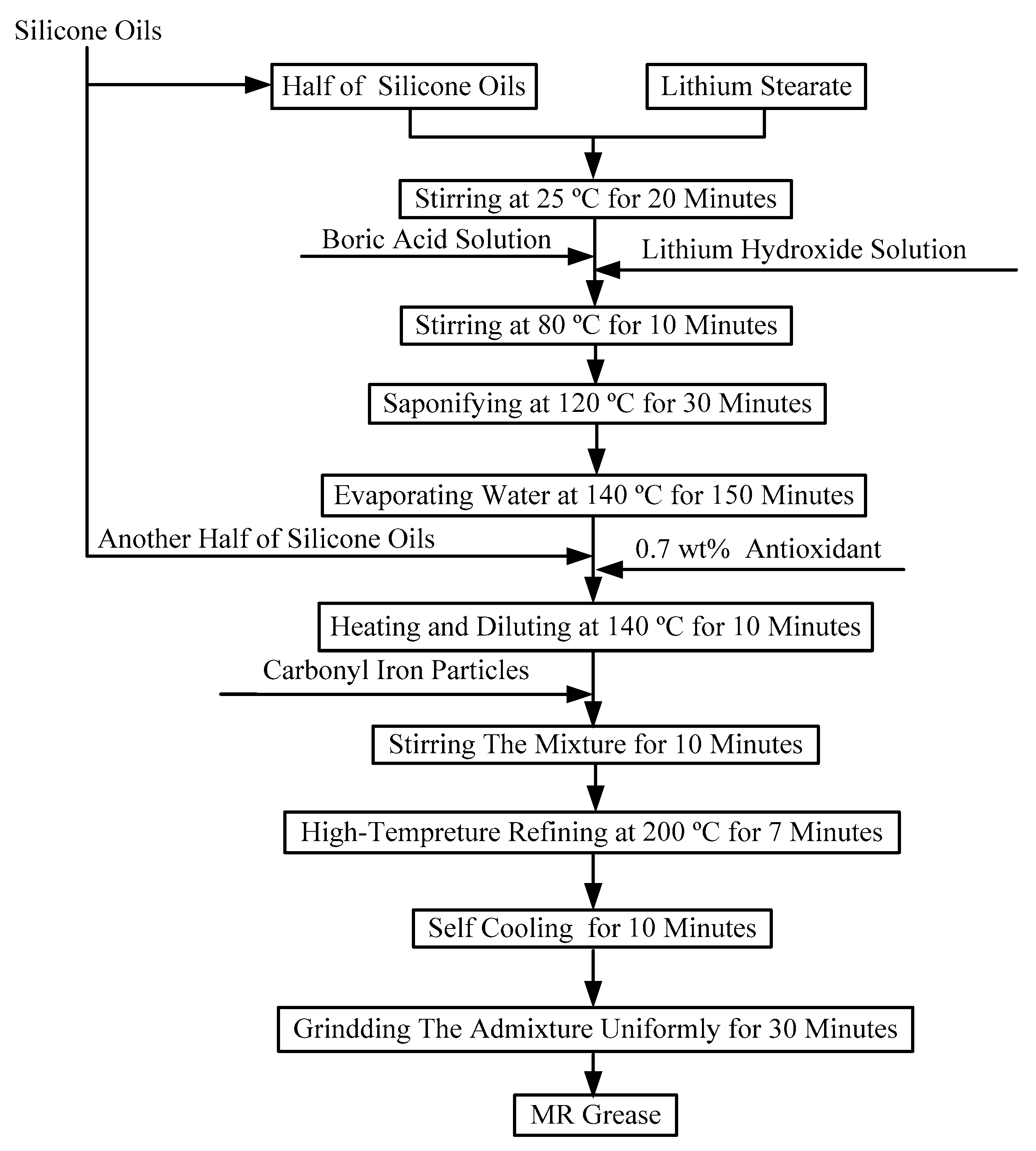
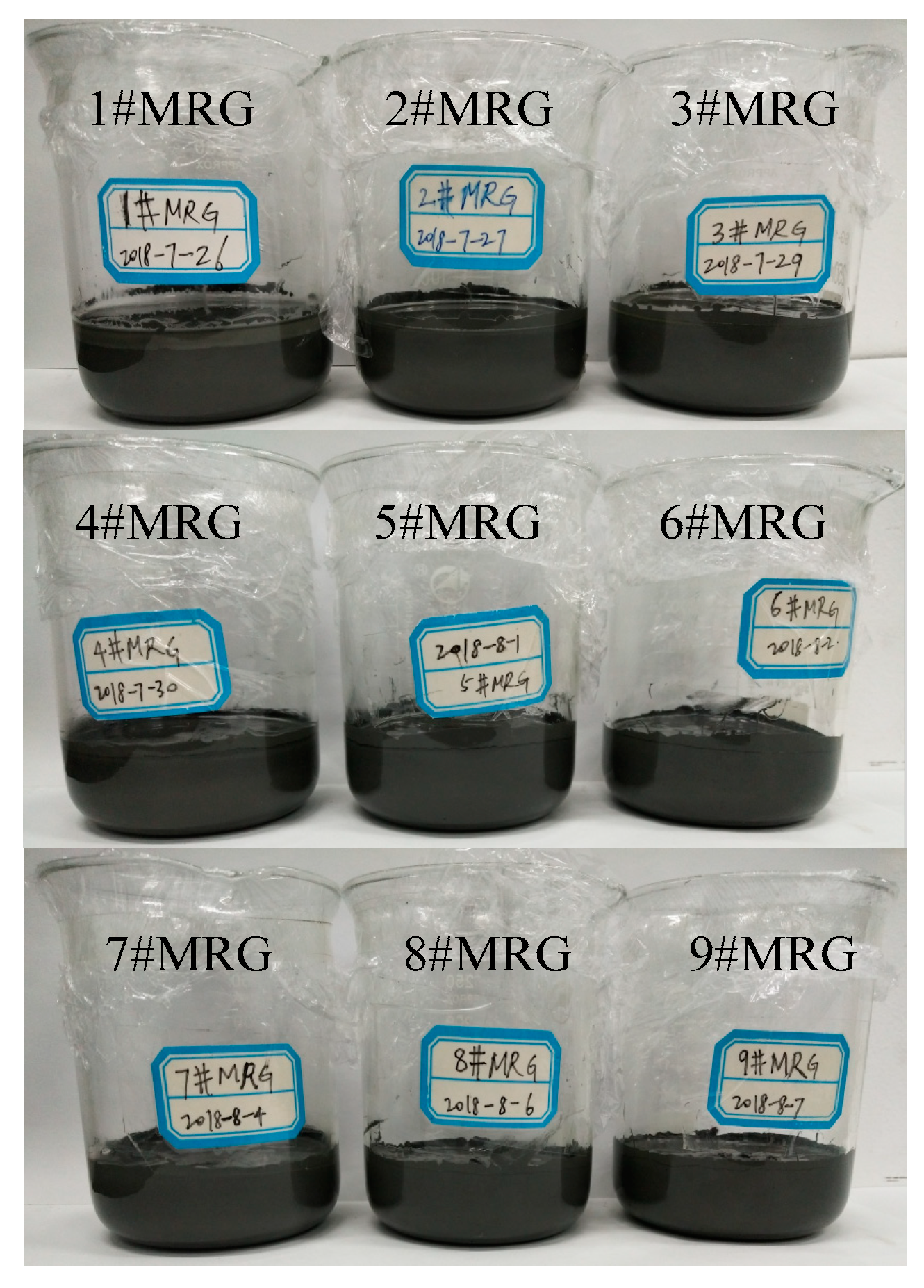
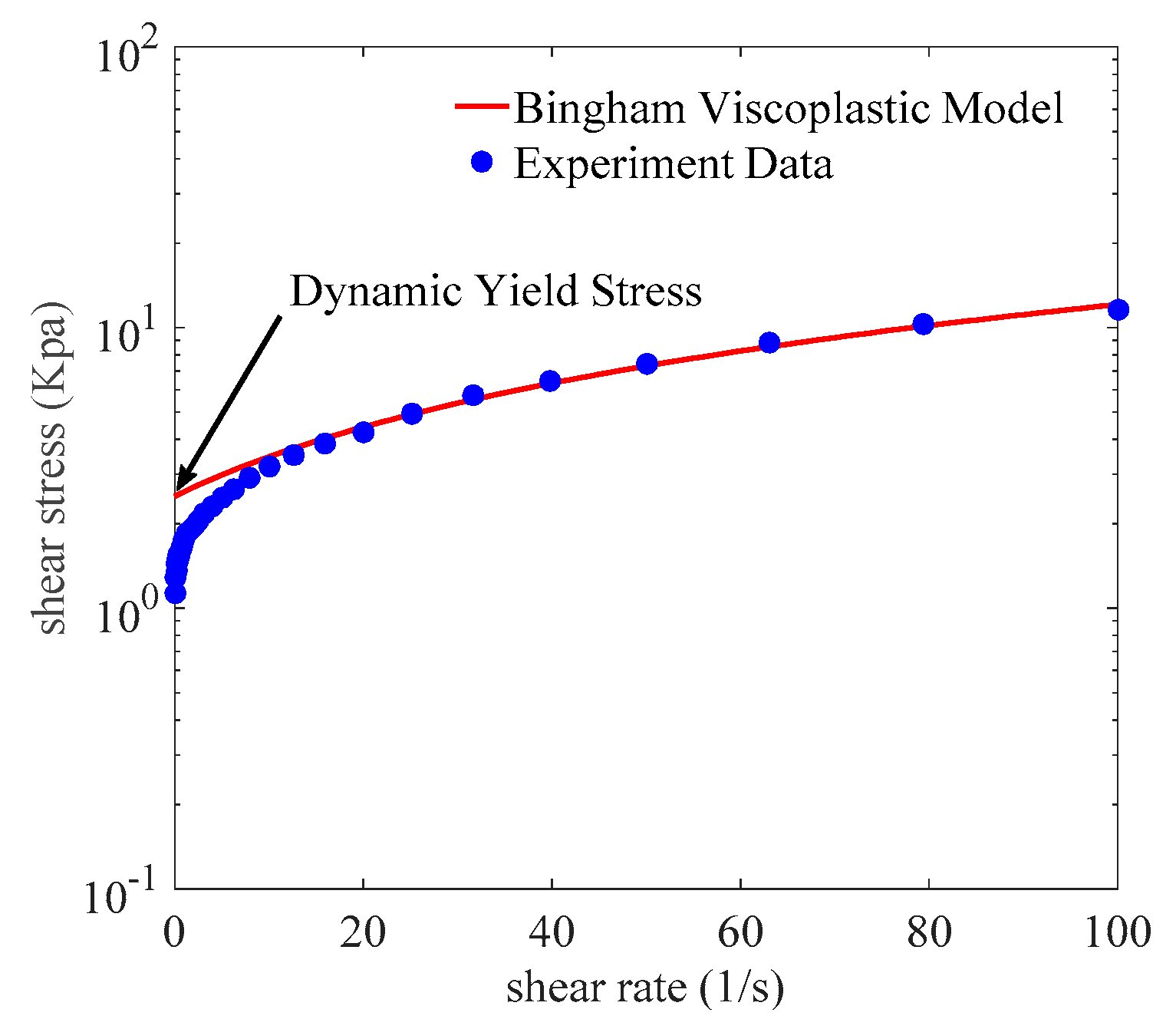
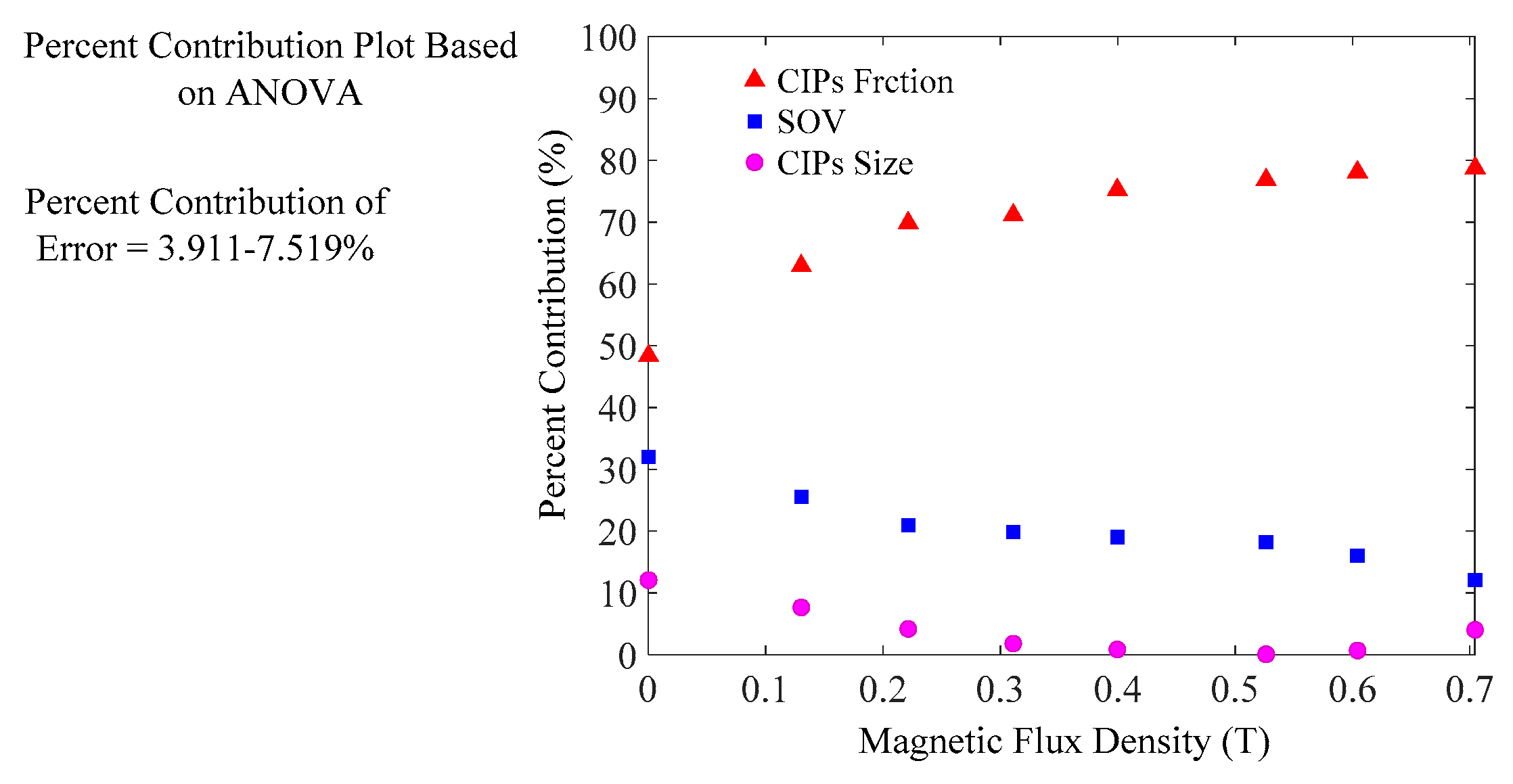
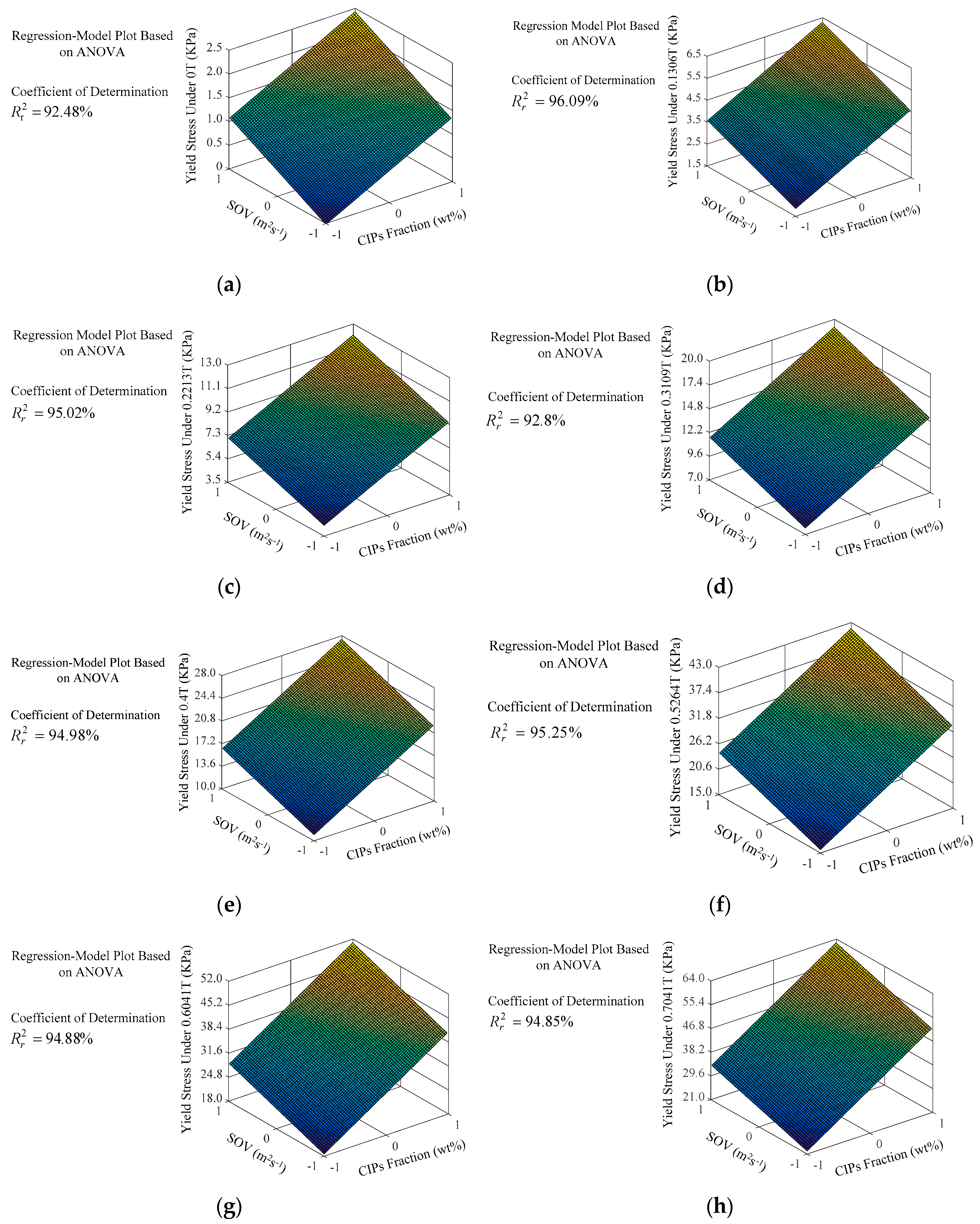
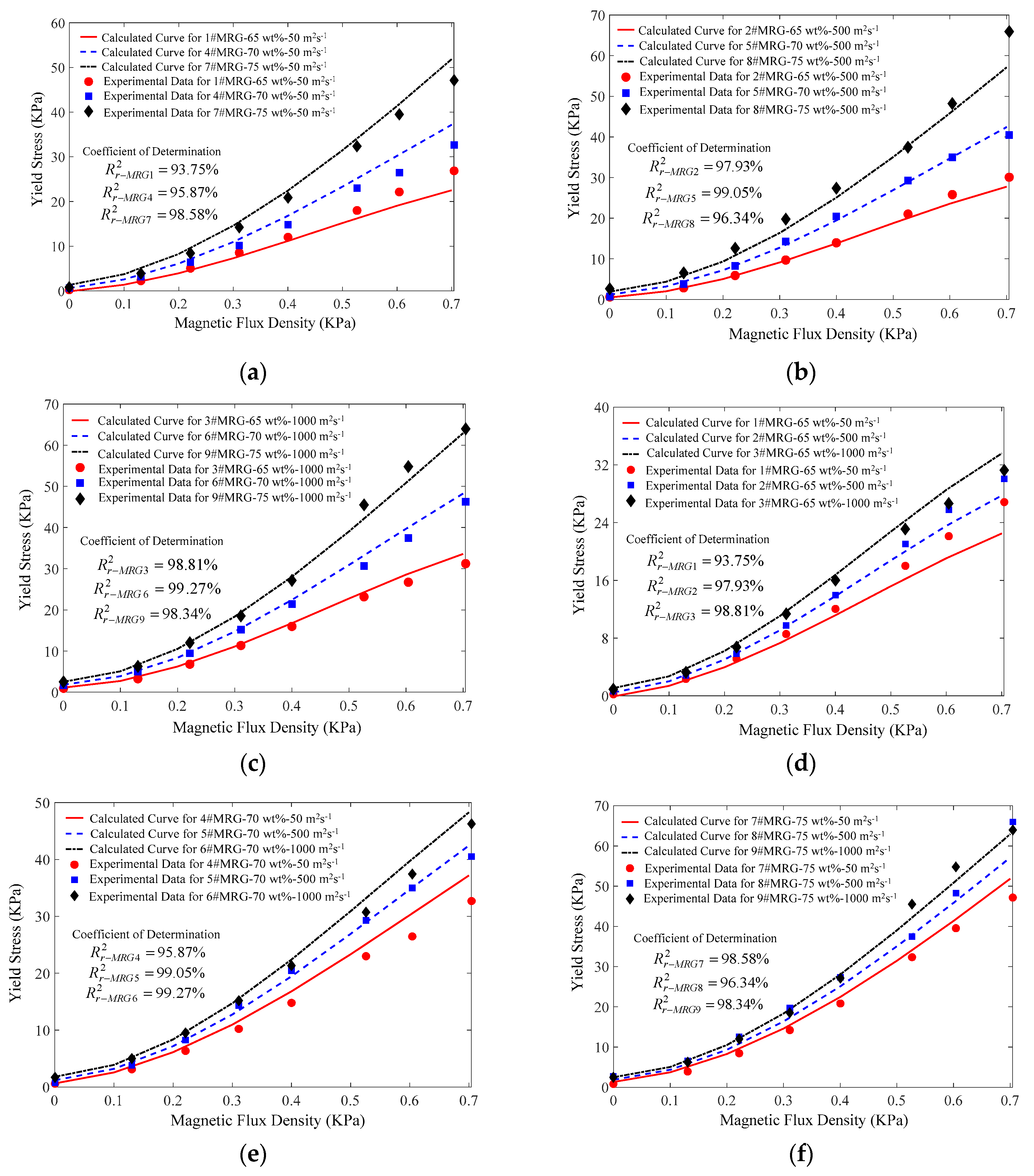
| Coding | Input Parameters and Their Levels | ||
|---|---|---|---|
| CIPs Fraction, X1 (wt%) | SOV, X2 (m2·s−1) | CIPs Size, X3 (μm) | |
| −1 | 65 | 50 | 3.2 |
| 0 | 70 | 500 | 3.5 |
| 1 | 75 | 1000 | 3.9 |
| Samples | Input Parameters | Response Parameters | |||||
|---|---|---|---|---|---|---|---|
| CIPs Fraction, X1 (wt%) | SOV, X2 (m2·s−1) | CIP Size, X3 (μm) | Yield Stress Under 0 T, Y0 (kPa) | Yield Stress Under 0.1306 T, Y1 (kPa) | Yield Stress Under 0.2213 T, Y2 (kPa) | Yield Stress Under 0.3109 T, Y3 (kPa) | |
| 1#MRG | −1 | −1 | −1 | 0.215 | 2.314 | 5.108 | 8.575 |
| 2#MRG | −1 | 0 | 0 | 0.648 | 2.828 | 5.846 | 9.742 |
| 3#MRG | −1 | 1 | 1 | 0.896 | 3.29 | 6.772 | 11.33 |
| 4#MRG | 0 | −1 | 0 | 0.618 | 3.1 | 6.381 | 10.19 |
| 5#MRG | 0 | 0 | 1 | 0.739 | 3.797 | 8.211 | 14.29 |
| 6#MRG | 0 | 1 | −1 | 1.681 | 4.99 | 9.466 | 15.17 |
| 7#MRG | 1 | −1 | 1 | 0.812 | 3.874 | 8.405 | 14.2 |
| 8#MRG | 1 | 0 | −1 | 2.663 | 6.546 | 12.55 | 19.74 |
| 9#MRG | 1 | 1 | 0 | 2.506 | 6.3 | 12.02 | 18.56 |
| Samples | Input Parameters | Response Parameters | |||||
|---|---|---|---|---|---|---|---|
| CIPs Fraction, X1 (wt%) | SOV, X2 (m2·s−1) | CIP Size, X3 (μm) | Yield Stress Under 0.4 T, Y4 (kPa) | Yield Stress Under 0.5264 T, Y5 (kPa) | Yield Stress Under 0.6041 T, Y6 (kPa) | Yield Stress Under 0.7041 T, Y7 (kPa) | |
| 1#MRG | −1 | −1 | −1 | 12.04 | 17.98 | 22.1 | 26.86 |
| 2#MRG | −1 | 0 | 0 | 13.99 | 21.03 | 25.77 | 30.08 |
| 3#MRG | −1 | 1 | 1 | 15.99 | 23.12 | 26.67 | 31.25 |
| 4#MRG | 0 | −1 | 0 | 14.79 | 23.02 | 26.48 | 32.67 |
| 5#MRG | 0 | 0 | 1 | 20.46 | 29.29 | 34.95 | 40.49 |
| 6#MRG | 0 | 1 | −1 | 21.36 | 30.7 | 37.42 | 46.25 |
| 7#MRG | 1 | −1 | 1 | 20.89 | 32.36 | 39.5 | 47.14 |
| 8#MRG | 1 | 0 | −1 | 27.41 | 37.45 | 48.27 | 65.96 |
| 9#MRG | 1 | 1 | 0 | 27.19 | 45.49 | 54.76 | 64.02 |
| Response Parameters | Source | SS | DOF | MS | Contribution | F | p |
|---|---|---|---|---|---|---|---|
| Yield Stress Under 0 T | Regression Model | 5.6843 | 3 | 1.89476 | 20.50 | 0.003 | |
| X1-CIPs Fraction | 2.9709 | 1 | 2.97088 | 48.336% | 32.14 | 0.002 | |
| X2-SOV | 1.9700 | 1 | 1.96997 | 32.050% | 21.31 | 0.006 | |
| X3-CIPs Size | 0.7434 | 1 | 0.74342 | 12.095% | 8.04 | 0.036 | |
| Error | 0.4622 | 5 | 0.09243 | 7.519% | |||
| Total | 6.1464 | 8 | 100.000% | ||||
| Yield Stress Under 0.1306 T | Regression Model | 17.5071 | 3 | 5.8357 | 40.95 | 0.001 | |
| X1-CIPs Fraction | 11.4485 | 1 | 11.4485 | 62.836% | 80.34 | <0.001 | |
| X2-SOV | 4.6675 | 1 | 4.6675 | 25.618% | 32.75 | 0.002 | |
| X3-CIPs Size | 1.3911 | 1 | 1.3911 | 7.635% | 9.76 | 0.026 | |
| Error | 0.7125 | 5 | 0.1425 | 3.911% | |||
| Total | 18.2196 | 8 | 100.000% | ||||
| Yield Stress Under 0.2213 T | Regression Model | 52.741 | 3 | 17.5803 | 31.78 | 0.001 | |
| X1-CIPs Fraction | 38.755 | 1 | 38.7553 | 69.820% | 70.05 | <0.001 | |
| X2-SOV | 11.659 | 1 | 11.6594 | 21.005% | 21.07 | 0.006 | |
| X3-CIPs Size | 2.326 | 1 | 2.3263 | 4.190% | 4.20 | 0.096 | |
| Error | 2.766 | 5 | 0.5533 | 4.985% | |||
| Total | 55.507 | 8 | 100.000% | ||||
| Yield Stress Under 0.3109 T | Regression Model | 113.663 | 3 | 37.888 | 21.49 | 0.003 | |
| X1-CIPs Fraction | 87.043 | 1 | 87.043 | 71.068% | 49.38 | 0.001 | |
| X2-SOV | 24.382 | 1 | 24.382 | 19.907% | 13.83 | 0.014 | |
| X3-CIPs Size | 2.239 | 1 | 2.239 | 1.828% | 1.27 | 0.311 | |
| Error | 8.814 | 5 | 1.763 | 7.197% | |||
| Total | 122.478 | 8 | 100.000% | ||||
| Yield Stress Under 0.4 T | Regression Model | 235.866 | 3 | 78.622 | 31.56 | 0.001 | |
| X1-CIPs Fraction | 186.707 | 1 | 186.707 | 75.187% | 74.95 | <0.001 | |
| X2-SOV | 47.152 | 1 | 47.152 | 18.988% | 18.93 | 0.007 | |
| X3-CIPs Size | 2.007 | 1 | 2.007 | 0.808% | 0.81 | 0.411 | |
| Error | 12.456 | 5 | 2.491 | 5.017% | |||
| Total | 248.322 | 8 | 100.000% | ||||
| Yield Stress Under 0.5264 T | Regression Model | 583.717 | 3 | 194.572 | 33.40 | 0.001 | |
| X1-CIPs Fraction | 471.175 | 1 | 471.175 | 76.883% | 80.87 | <0.001 | |
| X2-SOV | 112.234 | 1 | 112.234 | 18.314% | 19.26 | 0.007 | |
| X3-CIPs Size | 0.308 | 1 | 0.308 | 0.050% | 0.05 | 0.827 | |
| Error | 29.131 | 5 | 5.826 | 4.753% | |||
| Total | 612.848 | 8 | 100.000% | ||||
| Yield Stress Under 0.6041 T | Regression Model | 935.654 | 3 | 311.885 | 30.88 | 0.001 | |
| X1-CIPs Fraction | 770.440 | 1 | 770.440 | 78.126% | 76.29 | <0.001 | |
| X2-SOV | 157.799 | 1 | 157.799 | 16.002% | 15.63 | 0.011 | |
| X3-CIPs Size | 7.415 | 1 | 7.415 | 0.752% | 0.73 | 0.431 | |
| Error | 50.494 | 5 | 10.099 | 5.120% | |||
| Total | 986.148 | 8 | 100.000% | ||||
| Yield Stress Under 0.7041 T | Regression Model | 1588.45 | 3 | 529.48 | 30.72 | 0.001 | |
| X1-CIPs Fraction | 1318.09 | 1 | 1318.09 | 78.710% | 76.48 | <0.001 | |
| X2-SOV | 202.42 | 1 | 202.42 | 12.088% | 11.74 | 0.019 | |
| X3-CIPs Size | 67.94 | 1 | 67.94 | 4.057% | 3.94 | 0.104 | |
| Error | 86.17 | 5 | 17.23 | 5.145% | |||
| Total | 1674.62 | 8 | 100.000% |
| Magnetic Field, B/T | Yield Stress Coefficient, n/kPa | CIPs Fraction Coefficient, n∅/(kPa/wt%) | SOV Coefficient, nη/(kPa/m2·s−1) |
|---|---|---|---|
| 0 | 1.198 | 0.704 | 0.573 |
| 0.1306 | 4.115 | 1.381 | 0.882 |
| 0.2213 | 8.307 | 2.542 | 1.394 |
| 0.3109 | 13.533 | 3.809 | 2.016 |
| 0.4 | 19.347 | 5.578 | 2.803 |
| 0.5264 | 28.938 | 8.862 | 4.325 |
| 0.6041 | 35.1 | 11.33 | 5.13 |
| 0.7041 | 42.75 | 14.82 | 5.81 |
| Accuracy Evaluation | R2 | MSE |
|---|---|---|
| 1#MRG | 93.75% | 7.7984 |
| 2#MRG | 97.93% | 9.4778 |
| 3#MRG | 98.81% | 11.3449 |
| 4#MRG | 95.87% | 12.4756 |
| 5#MRG | 99.05% | 14.1563 |
| 6#MRG | 99.27% | 16.0243 |
| 7#MRG | 98.58% | 17.1744 |
| 8#MRG | 96.34% | 18.8538 |
| 9#MRG | 98.34% | 20.7205 |
© 2019 by the authors. Licensee MDPI, Basel, Switzerland. This article is an open access article distributed under the terms and conditions of the Creative Commons Attribution (CC BY) license (http://creativecommons.org/licenses/by/4.0/).
Share and Cite
Wang, K.; Dong, X.; Li, J.; Shi, K.; Li, K. Effects of Silicone Oil Viscosity and Carbonyl Iron Particle Weight Fraction and Size on Yield Stress for Magnetorheological Grease Based on a New Preparation Technique. Materials 2019, 12, 1778. https://doi.org/10.3390/ma12111778
Wang K, Dong X, Li J, Shi K, Li K. Effects of Silicone Oil Viscosity and Carbonyl Iron Particle Weight Fraction and Size on Yield Stress for Magnetorheological Grease Based on a New Preparation Technique. Materials. 2019; 12(11):1778. https://doi.org/10.3390/ma12111778
Chicago/Turabian StyleWang, Kejie, Xiaomin Dong, Junli Li, Kaiyuan Shi, and Keju Li. 2019. "Effects of Silicone Oil Viscosity and Carbonyl Iron Particle Weight Fraction and Size on Yield Stress for Magnetorheological Grease Based on a New Preparation Technique" Materials 12, no. 11: 1778. https://doi.org/10.3390/ma12111778
APA StyleWang, K., Dong, X., Li, J., Shi, K., & Li, K. (2019). Effects of Silicone Oil Viscosity and Carbonyl Iron Particle Weight Fraction and Size on Yield Stress for Magnetorheological Grease Based on a New Preparation Technique. Materials, 12(11), 1778. https://doi.org/10.3390/ma12111778





